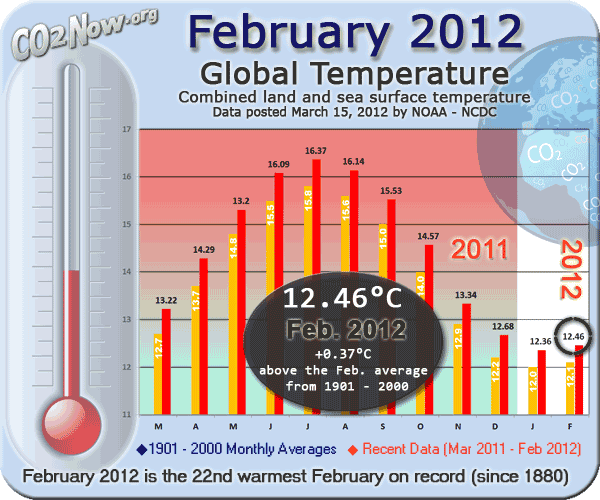|
394.45ppm
Atmospheric CO2 for March 2012
Preliminary data released April 5, 2012
(Mauna Loa Observatory: NOAA-ESRL)

|
CO2 Data Set: |
Original data file posted by the National Oceanic and Atmospheric Administration (NOAA) on Thursday April 5, 2012 |
|
|
|
|
Measuring Location: |
Mauna Loa Observatory, Hawaii |
| |
|
|
|
|
|
Data Source: |
Scripps CO2 Program UCSD / Scripps Institution of Oceanography |
| |
|
|
|
|
|
Why is CO2 significant? |
Carbon dioxide (CO2) is the chief greenhouse gas that results from human activities and causes global warming and climate change. To see whether enough is being done at the moment to solve these global problems, there is no single indicator as complete and current as the monthly updates for atmospheric CO2 from the Mauna Loa Observatory. |
| |
|
|
|
|
|
What is the current trend? |
|
| |
|
|
|
|
|
What level is safe? |
|
| |
|
|


The world's most current data for atmospheric CO2 is measured at the Mauna Loa Observatoy in Hawaii. Measurements are made and reported independently by two scientific institutions: Scripps Institution of Oceanography and the National Oceanic and Atmospheric Administration (NOAA). Monthly data is posted below.
Mauna Loa CO2 Data Sets:
NOAA CO2 Data
Scripps CO2 Data
|
|
|

 The 2011 average annual concentration of CO2 in the atmosphere (Mauna Loa Observatory) is 391.57 parts per million (ppm). The 2010 average is 389.78 ppm. The 2011 average annual concentration of CO2 in the atmosphere (Mauna Loa Observatory) is 391.57 parts per million (ppm). The 2010 average is 389.78 ppm.
For the past decade (2002-2011) the average annual increase is 2.07 ppm per year. The average for the prior decade (1992-2001) is 1.6 ppm per year. Annual data for 2011 was first posted January 5, 2012, by the National Oceanic and Atmospheric Administration (NOAA) in the United States.
Since the 1958 start of precision CO2 measurements in the atmosphere, the annual mean concentration of CO2 has only increased from one year to the next. The CO2 data below provide a simple view of the annual trend. |
|
Read more...
|
|
|

April 16, 2012
In March 2012, Earth's surface temperature was the 16th warmest on record since 1880. The month marks the 36th consecutive March and the 325th consecutive month with a global temperature above the 20th century average.
Global Temperature Rankings
Rank |
Measure |
Month |
Temperature
(above 20th Century average) |
|
16th |
Warmest (since 1880) |
March 2012 |
+0.46°C |
|
1st |
Warmest (since 1880) |
March 2010 |
+0.78°C |
|
1st |
Coolest (since 1880) |
March 1898 |
-0.64°C |
Data and information was first posted April 16, 2012 by National Oceanic and Atmospheric Administration (NOAA) and its National Climate Data Center (NCDC) in the USA.
Annually, 2011 is the 11th warmest year on record. The year 2010 tied with 2005 as the warmest year.
More details about global temperature are available in the State of the Climate reports (Global Analysis) at the NOAA-NCDC website. These reports present preliminary, global data that has been gathered from monitoring stations and leading institutions around the world. The reports include a Global Hazardssection that gives a global update on drought & wildfires, flooding, storms, severe winter weather, and ecosystems impacts. A Snow and Ice section reports on snow cover in the Northern Hemisphere and sea ice extent in the Northern and Southern Hemispheres.
NOTE: Global temperatures set out in the CO2Now graphic (above) are computed from preliminary NOAA estimates of global average temperature for the 20th century and adding the current 20th-century anomaly.
More Info from NOAA-NCDC:
NOAA NDCC | State of the Climate Global Analysis | REPORT
NOAA NDCC | Global land and ocean surface temperature anomalies since 1880 | DATA
NOAA NCDC | Q&As about global surface temperature anomalies | QUESTIONS & ANSWERS
NOAA NCDC | 2011 Annual State of the Climate Global Analysis | PRELIMINARY ANALYSIS
NOAA NCDC | 2010 Annual State of the Climate Highlights | 8 Page PDF
Related:
GISS | Global Temperature in 2011, Trends, and Prospects
Climate Interactive | UNEP Emissions Gap Report & Temperature-Related Tools
The Royal Society | Four degrees and beyond
CO2Now | The CO2Now Climate Sheet | |
|
Read more...
|
|
|

Updated April 16, 2012
Climate Sheet posts the world’s most current and important planetary data and targets – together in one place from leading global sources. The CO2Now Climate Sheet enumerates the chain of causes that are driving humanity’s largest environmental crises – global warming, climate change and ocean acidification. It also sets out key scientific markers for a stable climate system. |
|
Read more...
|
|
|
http://forio.com/simulation/climate-development/

Global CO2 Budget 2010
GlobalCarbonProject.org posted data for the 2010 Global Carbon Budget on December 5, 2011. Key findings are listed here:
* CO2 emissions grew 5.9% in 2010 to reach 9.1 GtC (33.5Gt CO2), overcoming a 1.4% decrease in CO2 emissions in 2009
* Including land-use change and deforestation, in 2010 emissions reached 10.0 GtC (36.8 Gt CO2)
* As of 2009 developing countries now emit more than developed countries in terms of consumption, and China now emits more than the US in terms of consumption
>>>> Links to the source data, credits and high-resolution images are given below. |
|
Read more...
|
|
|